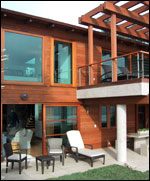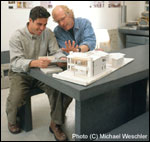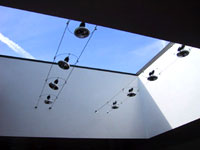Long before they joined the cast of “Saturday Night Live,” before she played Elaine on “Seinfeld” and he became a writer/producer for shows ranging from “The Single Guy” to “Frasier,” Julia Louis-Dreyfus and husband Brad Hall were devout environmentalists. Now they are key players in Hollywood’s green vanguard. Over the past decade she has been actively involved with nearly a dozen environmental organizations, including Heal the Bay, Natural Resources Defense Council, and Trust for Public Land; he is helping lead the effort at the Environmental Media Association to get energy-guzzling Hollywood studios to reform their wasteful operations.

Julia Louis-Dreyfus.
Photo: Michael Weschler.
But perhaps the most important project they’ve taken on so far is translating their long-held theories into personal practice. In the last year, the couple commissioned their friend David Hertz, a Santa Monica-based architect who specializes in green design, to transform their oceanfront bungalow just north of Santa Barbara into a showcase of green design and state-of-the-art energy efficiency mechanisms. The lengthy list of environmentally sensitive materials and building techniques Hertz integrated includes net-metered rooftop solar panels, sustainably harvested tropical woods, a natural ventilation system, and insulation made of recycled newspaper. The result is a house so efficient, so replete with creature comforts, and so sophisticated in its design that it redefines the energy-conscious lifestyle.
Grist sat down with the couple at their new home to discuss the power shift, and how they — and we — can help make it happen.
Politically active celebrities are often dismissed as having “pet causes,” but you represent the rare example of inveterate, well-informed activists who were involved in this cause well before your careers took off. Let’s start with the origins of your environmental activism. When did you first get involved in these issues?

An eco-friendly haven.
Photo: David Hertz.
Brad Hall: I grew up in Santa Barbara in the ’70s, so needless to say I have deep hippie roots. I learned how to surf as soon as I could walk. When I was about 12 years old, one of the oil derricks off the coast of Santa Barbara — which was built before they were outlawed — exploded because of a drilling pressure problem. I’ll never forget seeing all the beaches I’d grown up with coated with black sludge. The fish were belly-up, the birds were completely slimed. We had to rinse them off with gasoline to clean their feathers. It was incredibly disturbing, but also, I suppose, a turning point for me politically. The people of Santa Barbara started an anti-oil campaign called GOO!, for Get Oil Out! We all had GOO! bumper stickers. There was a peace sign in the middle of the “O” that stood for oil. It was very catchy back then, and though I haven’t seen a GOO! sticker in years, it’s more relevant today than ever.
Julia Louis-Dreyfus: I never had any kind of defining experience like that — no specific turning point or activist rite of passage. I grew up spending a lot of time in Wyoming, hiking and so forth, so I certainly had an early appreciation for the natural world. I also spent years as a kid traveling in the developing worlds. We lived in Sri Lanka for a year, Colombia, Tunisia, where my stepfather was working as a doctor with Project Hope. I was made aware of the idea of being a part of something bigger than you, something bigger than our lives. That impulse is definitely what now drives my environmental work. It’s certainly part of what compelled me to want to live efficiently and build this house — to support solutions to problems that reach well beyond my lifetime.
Hall: We met at Northwestern University during the Carter era, so conservation was certainly a part of our ethos. I had a comedy troupe called The Practical Theater, which Julia joined, and in our skits we parodied the problems of the day — oil dependency, environmental negligence, a lot of the issues we’re now seeing reemerge on the public radar.
Louis-Dreyfus: Ha! I don’t even remember those skits. I was about 19 at the time and had fallen head over heels in love with Brad. He was a senior with a big old beard and Jesus hair. I may have been just taking his word for it at that point.
So when did you become a convert, both in theory and practice? When did you begin committing yourselves to living energy-efficient lifestyles?
Louis-Dreyfus: I am hardly by nature an efficient person. I’ve always had lots of clutter in my life, you know, I’m a consumer. I love the creature comforts. I can’t live without my cappuccinos, my hot showers, that kind of thing. Brad, on the other hand, would live in a tent if he could, but that’s not me. It’s only been until recently that all these practical solutions have emerged for consumers to live efficiently without making big sacrifices. I’m not the type to ride a bike to work everyday, but I’ll damn well buy a hybrid-engine car. I’m not the type to cut back on hot showers, but there’s no harm in hot water when it’s warmed by the sun.
Hall: I’d say my devotion to environmental issues is still as strong as it was in the ’70s, but the lifestyle options available to us have changed dramatically. It’s absolutely amazing that in the last five years or so there’s been such an explosion of efficiency innovations. In 1998, I got an electric car, a Honda EV [Editor’s note: this model has since been discontinued], when only a few thousand were released on the market. This was far from a mainstream option. In the last three years, hundreds of thousands of hybrid-electric cars have been released, and demand is rocketing. Amazing!

David Hertz and Brad
Hall examine a model
of the house.
Photo: Michael Weschler.
Yeah, and at the same time, green building innovations have made an equally dramatic entrance into the mainstream.
Hall: Absolutely. At first, we didn’t even realize the extent of the possibility. We didn’t plan on making this house a model of green building; it was just going to be a small addition of two bedrooms and a bathroom. But then we met architect David Hertz, who runs the Santa Monica-based architecture firm Syndesis and is a green-building visionary. Our kids go to school together. I was dropping my son off at his house and I was absolutely blown away. It’s essentially a laboratory for green design. When we saw that house, we knew we could live in a green household that was also incredibly sophisticated design-wise.
Take us on a tour of some of the energy-efficiency innovations in your house.

Open wide: the retractable
roof.
Photo: David Hertz.
Louis-Dreyfus: My favorite thing is the retractable roof. It functions as a “thermal chimney” that exhausts hot air upward and draws ocean breezes through the windows. All the rooms are connected by transom windows so that the air is constantly circulating and there’s no need for air conditioning, which dramatically diminishes energy demand. It also does wonders to integrate the outside world — the gulls and pelicans and weather patters circling overhead. There’s this moisture sensor that automatically shuts the roof if it begins to rain. But there’s no protection against the birds. It’s only a matter of time before one of those things takes a crap in the house. I’m not too keen on that, but what can I tell ya? They live there too.
Hall: There’s generous use of glass, which means there’s minimal need for electric lighting. The window glass is laminated with a “heat mirror,” so warmth is not lost when it’s cool outside, or let in when it’s hot. The lighting is energy-efficient halogen, and the kitchen appliances and washer/dryer are all Energy Star-certified. The rooftop solar thermal panels produce hot water that flows through radiant tubing in the floors to heat the house; the rooftop photovoltaic panels are net-metered so that during the week when we’re in L.A. and the house is empty and the energy goes unused, it is pumped directly back into the grid and creates a credit at the local utility. Also, we asked our Santa Barbara-based contractor Jed Hirsch to be sure that all the lumber, doors, windows, plumbing, and electrical fixtures gutted from the original house were salvaged and donated to a builder’s exchange for reuse. That way all the embodied energy used to make those things wasn’t just wasted.
In what areas were you not able to be energy-efficient?

Bamboo stairway to
the stars.
Photo: David Hertz.
Hall: Let’s face it: Having a second home is itself a sort of appalling excess. We figured if we’re going to do it, we better be as responsible as we can. We were diligent about keeping the scale small and trying to get as many of our materials and labor locally, so they didn’t have to travel long distances. Admittedly, some of the tropical hardwoods — the bamboo and sustainably harvested mahogany and ipe — were shipped in from countries like Guatemala and Honduras. Oh, and there are a few items like the Jacuzzi that kick up the energy load, but we make up for it with efficiencies elsewhere. The larger point is that living efficiently is not about asceticism, it’s about balance.
Like for instance that Porsche Roadster I saw parked in the driveway next to your Honda EV — is that yours?
Hall: Yes, but that gets around 30 miles per gallon, which you have to admit isn’t bad. I generally use the EV for my daily commutes. Unfortunately, I’ll eventually have to retire it because there’s nowhere to service electric vehicles anymore. To my mind this is nothing short of a national tragedy. The electric car is a brilliant solution to our energy woes. We already have a comprehensive electricity system in place; all we have to do is pump in the renewable energy to make it clean. The auto industry has given up on it — probably currying favor to the petroleum industry. We just bought two Toyota Priuses, which we’ll be using for most of our daily travel.
What are the motivating factors behind your eco-warrior lifestyles?
Louis-Dreyfus: This is a really scary time right now. The war and terrorism in the Middle East, the crisis of leadership in many of these oil-supply countries in the developing world, the crisis of global warming — all these are very clearly tied to energy. I mean, what the hell is going on? Why isn’t our leadership connecting the dots? What’s so frightening about these issues is feeling like you don’t have any control over them. So for me, these lifestyle decisions are a way of having control and feeling less guilty. I walk around feeling a sort of existential guilt all the time; for me this house is a way of feeling less guilty about the universe.
Can you elaborate on this guilt feeling?
Louis-Dreyfus: As Americans we are incredibly fortunate. We are 5 percent of the world’s population and consume a third of the total resources. We should all feel guilty relative to the world.
Some people are more conscious of where things come from and where they go. It’s connected to the idea that you respect your neighbor as yourself. It will make you happier and your neighbor happier, but of course it’s also an emotional burden. I am a worrier by nature. I worry and I feel guilty and if there’s anything I can do to take control I feel less worried and less guilty. When I’m listening to Rush Limbaugh or one of these real right-wingers talk, I’m struck by the fact that they don’t seem to feel a connection to their surroundings — no connection to those who are disenfranchised, or not represented, or have less, or lost a war, or whatever it is. There is an alarming disconnect between himself and his neighbor. And in a way it’s very egocentric, and underdeveloped emotionally.
Of all the environmental issues, is energy the one that concerns you the most?
Louis-Dreyfus: I’d say population growth is equally urgent. The problem of resource depletion clearly goes hand in hand with the growth in demand.
Hall: The message really couldn’t be any clearer: If you’re looking for the magic bullet that will solve both our global warming crisis and our growing foreign policy crises, change the energy system. It’s absolutely amazing to me that our leaders and especially the Democratic candidates aren’t picking up on this. Beyond the energy issue, water pollution and conservation is also becoming a crisis of similar proportions.
How do we help the public at large connect the dots between these crises? How can we further mobilize people around these issues?
Louis-Dreyfus: My fear is that things are going to have to get a lot worse before anyone really makes this connection. We need leadership. It takes somebody with a true vision to lead us through this time. Not someone who is making decisions based on poll results and fear of how they’re being perceived. We need a Martin Luther King kind of leader. A genius, a warrior type. Someone who is willing to risk their careers and personal lives to put their ideologies ahead of everything else. It will take that kind of leadership to get us through this.
Hall: It’s too early to tell whether any of the Democratic candidates are really prepared to emerge as such a leader, but the cultural and political circumstances today are undoubtedly calling for it.
What about celebrities? In the absence of political leadership, can cultural icons wake Americans up from their apathy?

Sexy rooftop solar panels.
Photo: David Hertz.
Louis-Dreyfus: One of my goals is simply to try and help make environmental lifestyle decisions cool and sexy. It sounds trite, but certainly in a consumer-based society, this can be an incredibly effective form of activism. When Leo DiCaprio or Cameron Diaz is seen driving a hybrid-engine car to the Oscars, that has far-reaching influence. They help shake off the idea that environmentalism is a hippie-crunchy-granola-fringe movement. They can be very effective in the marketing of these solutions. Soon enough, people will realize that these solutions are as important for practical economic reasons; they not only reduce our energy demands, but save money on gas and electricity bills.
What about the backlash against celebrities such as the Dixie Chicks for speaking out on political issues? Are you concerned that speaking your political mind could undermine your career?
Louis-Dreyfus: Absolutely not. This has never concerned me. What concerns me is when people or the media dismiss it as insincere — as some kind of Hollywood pet cause.
Hall: I think it’s perfectly fine to speak out emotionally, but it can be dangerous. It is dangerous to assume celebrities are experts. Julia and I are avid activists, but we would never call ourselves experts on these matters. It’s dangerous when celebrities that star as, say, farmers are brought before the committee on farm issues. It has led to mistakes.
Does it frustrate you that Hollywood as an industry is so environmentally negligent?
Hall: Hollywood studios are unbelievably wasteful and resource intensive. Big generators running all day long, massive diesel generators that provide the 220-volt power to run the cameras, the lights, the motor homes for the actors. Big cars and trucks carry all the sets, props, actors back and forth to the filming location. And there’s huge use of hardwoods in sets, unbelievable, that just get thrown away. Until recently, there was no recycling of sets or recycling of scripts; new script pages are printed every day.
I’m involved in the Environmental Media Association, which not only advocates environmental content in TV shows and movies — even just placing a recycling bin in the kitchen on a sitcom has a huge influence on mainstream lifestyles — but also tries to improve the operations of the industry. We’re trying to encourage them to use clean diesel and improve generator efficiency, to have at least one hybrid car, whether on-camera or off-camera — anything to make people more aware. We have a big award ceremony and studios now compete to get an EMA green seal for efficiency. We’re seeing very good progress so far.
What else can we do to encourage mainstream support of energy independence?
Louis-Dreyfus: Again, I think it comes back to marketing savvy. There was a great opportunity after 9-11, when our dependence on foreign oil was exploding as an issue, for car manufacturers to launch a hybrid car called “Patriot” and paint it red, white, and blue. They would have made a killing.
Hall: We need an alternative to the dry, multisyllabic phrases like “energy independence” and “sustainable energy.” Frankly I think GOO! might catch on like wildfire.


